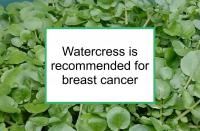Watercress (Nasturtium officinale), a cruciferous vegetable, has been shown to have antioxidant, anti-genotoxic, and anti-inflammatory properties, and to improve cholesterol profile. Watercress contains significant levels of beneficial micronutrients such as isothiocyanates.
Watercress is a source of the isothiocyanates benzyl isothiocyanate (BITC) and phenethyl isothiocyanate (PEITC). In addition, watercress is a good source of the carotenoids beta-carotene and lutein, as well as kaempferol and vitamin C.
Breast cancer-related effects of eating watercress
Watercress consumption is associated with reduced breast cancer risk. Isothiocyanates derived from watercress have been found to have chemopreventive activity against a variety of breast cancer cell lines in the laboratory and in epidemiologic studies.
Epidemiological studies
A number of population studies have found a lower risk of breast cancer associated with consumption of one or more cruciferous vegetables. For example, a Chinese study which measured urinary isothiocyanate levels as a marker of cruciferous vegetable intake found that higher levels were protective against breast cancer in both premenopausal and postmenopausal women. Another carefully designed study of Chinese women found that cruciferous vegetable consumption was associated with significantly reduced breast cancer risk. Yet another study based on Italian and Swiss populations reported that consuming cruciferous vegetables at least once per week was associated with a 17% lower risk of breast cancer compared with never or only occasionally consuming cruciferous vegetables.
Watercress can increase treatment effectiveness
PEITC has been found to enhance the sensitivity of the breast cancer cells to radiotherapy and doxorubicin. Lutein has been shown to potentiate the effect of taxane chemotherapy drugs paclitaxel and docetaxel in breast cancer cells.
Beta-carotene enhanced the cytotoxicity of doxorubicin in hormone receptor positive (ER+/PR+) and triple negative (ER-/PR-/HER2-) breast cancer cells in one study. Beta-carotene has also been demonstrated to reduce multidrug resistance in cancer cells. Watercress compound kaempferol has been shown to reduce the degree of heart and kidney damage caused by doxorubicin in rat models of chemotherapy. In addition, treatment with beta-carotene has been shown to reduce cardiotoxicity induced by the chemotherapy drug cisplatin in rats.
Important micronutrients in watercress
Watercress isothiocyanates
Urinary isothiocyanate levels have been found to be related to lower breast cancer risk among both premenopausal and postmenopausal women.
BITC
BITC has been found to induce cell death in both ER+/PR+ and triple negative breast cancer cells. BITC has also been shown to inhibit self-renewal of breast cancer stem cells and to reduce mammary tumor development in a mouse model of HER2 overexpressing (HER2+) breast cancer.
PEITC
Watercress is the most abundant dietary source of PEITC. PEITC has been shown to reduce the growth of human breast cancer cells and decrease angiogenesis (the process by which tumors send out signals to induce surrounding normal tissues to grow new blood vessels into the tumor). In addition, PEITC has been demonstrated to inhibit the growth of HER2+ mammary tumors in mice and inhibit metastasis to the brain in a mouse model of breast cancer.
Carotenoids
Women with substantial intake of carotenoids such as beta-carotene and lutein have been reported to have lower risks of breast cancer and its recurrence than those with low intake, although not all studies are in agreement.
Beta-carotene
A Scandinavian study found that dietary (but not supplemental) beta-carotene had a protective effect against lobular breast cancer in postmenopausal women. Another European study reported that high intake of beta-carotene was protective against breast cancer in postmenopausal women using hormone replacement therapy (HRT). The same study also found that dietary beta-carotene was associated with lowered risk of breast cancer in postmenopausal women with relatively high alcohol consumption.
Lutein
Lutein consumption and circulating lutein levels have also been found to be associated with reduced risk of breast cancer in several epidemiological studies. Lutein has been shown to inhibit the progression of both ER+/PR+ and triple negative breast cancer cells under hypoxia, a low-oxygen condition in which solid breast tumors can thrive.
Kaempferol
Diets abundant in kaempferol have been found to be associated with reduced breast cancer risk. Kaempferol has been shown to inhibit the growth of ER+/PR+ breast cancer cells, in part through inhibition of glucose uptake. Kaempferol has also been found to inhibit both primary tumor growth and lung metastasis in a mouse model of breast cancer. In addition, kaempferol may protect against the cancer-promoting effects of triclosan, an antibacterial chemical to which most people are routinely exposed which is an endocrine disruptor.
Additional comments
Watercress should be eaten raw rather than cooked to obtain the most powerful anti-cancer effects.
Garden cress (Lepidium sativum) is a cruciferous vegetable related to watercress that has similar chemopreventive properties.
Sources of information provided in this webpage
The information above, which is updated continually as new research becomes available, has been developed based solely on the results of academic studies. Clicking on any of the underlined terms will take you to its tag or webpage, which contain more extensive information.
Below are links to 20 recent studies concerning this food and its components. For a more complete list, including less recent studies, please click on watercress.
